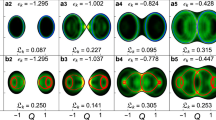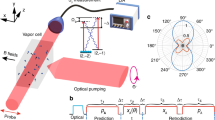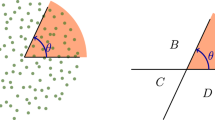Abstract
Heisenberg's principle1 states that the product of uncertainties of position and momentum should be no less than the limit set by Planck's constant, ℏ/2. This is usually taken to imply that phase space structures associated with sub-Planck scales (≪ℏ) do not exist, or at least that they do not matter. Here I show that this common assumption is false: non-local quantum superpositions (or ‘Schrödinger's cat’ states) that are confined to a phase space volume characterized by the classical action A, much larger than ℏ, develop spotty structure on the sub-Planck scale, a = ℏ2/A. Structure saturates on this scale particularly quickly in quantum versions of classically chaotic systems—such as gases that are modelled by chaotic scattering of molecules—because their exponential sensitivity to perturbations2 causes them to be driven into non-local ‘cat’ states. Most importantly, these sub-Planck scales are physically significant: a determines the sensitivity of a quantum system or environment to perturbations. Therefore, this scale controls the effectiveness of decoherence and the selection of preferred pointer states by the environment3,4,5,6,7,8. It will also be relevant in setting limits on the sensitivity of quantum meters.
This is a preview of subscription content, access via your institution
Access options
Subscribe to this journal
Receive 51 print issues and online access
$199.00 per year
only $3.90 per issue
Buy this article
- Purchase on Springer Link
- Instant access to full article PDF
Prices may be subject to local taxes which are calculated during checkout



Similar content being viewed by others
References
Heisenberg, W. Über den anschaulichen Inhalt der quantentheoretischen Kinematik and Mechanik. Z. Phys. 43, 172–198 (1927); The physical content of quantum kinematics and mechanics (Engl. Trans.) in Quantum Theory and Measurement (eds Wheeler, J. A. & Zurek, W. H.) (Princeton Univ. Press, Princeton, 1983).
Zurek, W. H. Decoherence, chaos, quantum-classical correspondence, and the algorithmic arrow of time. Phys. Script. T76, 186–198 (1998).
Zurek, W. H. Pointer basis of a quantum apparatus: Into what mixture does the wavepacket collapse? Phys. Rev. D 24, 1516–1524 (1981).
Zurek, W. H. Environment-induced superselection rules. Phys. Rev. D 26, 1862–1880 (1982).
Joos, E. & Zeh, H. D. The emergence of classical properties through the interaction with the environment. Z. Phys. B 59, 229 (1985).
Zurek, W. H. Decoherence and the transition from quantum to classical. Phys. Today 44, 36–46 (1991).
Giulini, D., Joos, E., Kiefer, C., Kupsch, J., Stamatescu, L.-O. & Zeh, H. D. Decoherence and the Appearance of a Classical World in Quantum Theory (Springer, Berlin, 1996).
Zurek, W. H. Decoherence, einselection, and the quantum origin of the classical. Rev. Mod. Phys. (in the press); also as preprint (quant-ph 010527) at 〈http://xxx.lanl.gov〉 (2001).
Haake, F. Quantum Signatures of Chaos (Springer, Berlin, 1991).
Casati, G. & Chrikov, B. Quantum Chaos (Cambridge Univ. Press, Cambridge, 1995).
Hillery, M., O'Connell, R. F., Scully, M. O. & Wigner, E. P. Distribution functions in physics: Fundamentals. Phys. Rep. 106, 121–167 (1984).
Berry, M. V. & Balazs, N. L. Evolution of semiclassical quantum states in phase space. J. Phys. A 12, 625–642 (1979).
Korsch, H. J. & Berry, M. V. Evolution of Wigner's phase-space density under a nonintegrable quantum map. Physica D 3, 627–636 (1981).
Zurek, W. H. & Paz, J. P. Decoherence, chaos, and the Second Law. Phys. Rev. Lett. 72, 2508–2511 (1994).
Berman, G. P. & Zaslavsky, G. M. Condition of stochasticity in quantum non-linear systems. Physica (Amsterdam) 91A, 450 (1978).
Habib, S., Shizume, K. & Zurek, W. H. Decoherence, chaos, and the correspondence principle. Phys. Rev. Lett. 80, 4361 (1998).
Caldeira, A. O. & Leggett, A. J. Path-integral approach to quantum Brownian motion. Physica 121A, 587–616 (1983).
Paz, J. P. & Zurek, W. H. in Les Houches Lectures Session LXXII (eds Kaiser, R., Westbrook, C. and David, F.) 533–614 (Springer, Berlin, 2001).
Braun, D., Haake, F. & Strunz, W. A. Universality of decoherence. Phys. Rev. Lett. 86, 2913–2917 (2001).
Hannay, J. H. & Berry, M. V. Quantization of linear maps on a torus—Fresnel diffraction by a periodic grating. Physica 1D, 267–290 (1980).
Caves, C. in Physical Origins of Time Asymmetry (eds Halliwell, J. J., Pérez-Mercader, J. & Zurek, W. H.) 47–77 (Cambridge Univ. Press, Cambridge, 1993).
Miller, P. A. & Sarkar, S. Signatures of chaos in the entanglement of two coupled quantum kicked tops. Phys. Rev. E 60, 1542 (1999).
Braginsky, V. B. & Khalili, F. Y. Quantum nondemolition measurements: the route from toys to tools. Rev. Mod. Phys. 95, 703–711 (1996).
Karkuszewski, Z., Zakrzewski, J. & Zurek, W. H. Breakdown of correspondence in chaotic systems: Ehrenfest versus localization times. Preprint quant-ph/0010011 at 〈http://xxx.lanl.gov〉 (2000).
Acknowledgements
This research was supported in part by the National Security Agency. I thank A. Albrecht, N. Balazs, C. Jarzynski, Z. Karkuszewski and J. P. Paz for useful chaotic conversations.
Author information
Authors and Affiliations
Corresponding author
Rights and permissions
About this article
Cite this article
Zurek, W. Sub-Planck structure in phase space and its relevance for quantum decoherence. Nature 412, 712–717 (2001). https://doi.org/10.1038/35089017
Received:
Accepted:
Issue Date:
DOI: https://doi.org/10.1038/35089017
This article is cited by
-
Experimental realisations of the fractional Schrödinger equation in the temporal domain
Nature Communications (2023)
-
Semiclassical and thermal phase space entropies measuring complexity
Journal of Mathematical Chemistry (2023)
-
Slowing quantum decoherence of oscillators by hybrid processing
npj Quantum Information (2022)
-
Mth Coherent State Induces Patterns in the Interaction of a Two-Level Atom in the Presence of Nonlinearities
International Journal of Theoretical Physics (2021)
-
Coordinated self-interference of wave packets: a new route towards classicality for structurally stable systems
Scientific Reports (2020)
Comments
By submitting a comment you agree to abide by our Terms and Community Guidelines. If you find something abusive or that does not comply with our terms or guidelines please flag it as inappropriate.



